Watching an episode of Grand Designs recently, while on holiday, made me thankful that we don’t have such a high and idiotic level of bureaucracy as they do in England: but then again, nor do we have an architectural presenter with the charisma and sardonic tongue of Kevin McCloud.
In this programme, an architect called Francis Shaw was attempting to restore a castle in Skipton, in Yorkshire. His object of decrepid fascination was known as Peel Castle – more of a large country house really, but it did have a castellated top (or did, once it was “restored”).
Ok, yes, Francis was, to my eyes, incredibly naive, to try to buy and live in a listed Ancient Monument without having first gained listed building consent. There were very few people who had wanted to save the castle – one gets the feeling that English Heritage would have been just as happy to have had a total ruin, rather than have to deal with someone attempting restoration.
The job required an Archaeological assessment (which started at 8,000 quid and ended up over 20,000 quid), and of course extensive stonework by masons: but of course also required huge amounts of paperwork. In the case of Peel Castle, it required Scheduled Ancient Monument Consent: which apparently has to go as far up the greasy pole as to get permission from the Secretary of State.
Luckily, we don’t have to go to quite such extents in New Zealand – which is just as well as I don’t know if I would trust an equivalent MP in NZ to have any say in a building. Most of the MPs haven’t a clue about architects, or architecture. There are, of course, no architects as MPs in NZ (and with the exception of a few Lords in the UK, probably none there either). But English Heritage is taken a lot more seriously in the UK than our equivalent: New Zealand Historic Places Trust.
Our NZHPT is a woefully under-funded beast – toothless, clawless, and largely blind to boot, like an aged labrador that wants to play ball but can really only sit there wagging its tail, whining and piddling in the corner. They are severely under-resourced. Their Register is incomplete and long out of date. And, to my eyes somewhat bizarrely, at present the HPT seems to have a far stronger bent towards the Archaeology side of things than it does to the Architectural side. But that may just be my personal angle: living, breathing people and their lived-in, working buildings are so much more interesting to me than unearthing pre-Victorian pots and pans, and dead and buried piles of bones and rotting ponga.
While we did previously have a Minister in charge of Culture and Heritage who sat right at the top of the pecking order, sadly, the hopes of the HPT during the Labour Government were dashed just as assuredly as if Clark was a back-bencher: no further money was incoming to the HPT kitty. It is therefore just as anaemic and toothless as it was, still under-staffed and under-resourced, and is unlikely to be treated much better by the new Minister in Key’s new National Government.
English Heritage’s spokesperson on Grand Designs commented that Ancient Monuments were rare in Britain – and then – did my ears hear right – he noted that there were only 22,000 buildings on their List, and that they didn’t own them all. I almost fell from the boat back into the water as I listened to that.
Our HPT is a very poor cousin indeed – although of course we have a commensurately far smaller quota of historic buildings as well. The HPT register of historic places and buildings is incomplete in both length and detail, and open to abuse on both sides of the fence. In the most recent case we know of, that of the St Johns Church Hall in Napier, an HPT volunteer worked hard to get the old Hall listed, whereupon the HPT gave it a Grade 1 listing (you can get no higher) which presumably meant that the building had considerable merit. The local vicar disagreed with that, kicked up a fuss, and then the City Council approved a demolition order anyway: negating the point of any work done. In England, it seems, the developer would have had to retain it, pay for an Archaeological report and pay for strengthening works at the least – whereas here we seem happy to allow to put the bulldozer through and turn it into carpark.
Of course: that would never happen in Wellington, would it? Or would it? The Council here take heritage quite seriously: in fact WCC heritage officers have been steadily working through a number of proposed new Heritage listings, something that they plan to do every few years after researching: adding more notable buildings to the list. Not everyone is happy with this adding to the Heritage list however, and with the last proposed additions to the list in Plan Change 52, owners of at least two sites managed to argue themselves out of any Heritage listing, leaving themselves free to demolish at ease. There is an excellent summary of the pros and cons of one of these two sites on the old WellUrban site (indeed, “Bring Back WellUrban!”)
So: be prepared to say goodbye to Old Wool House, which the friends and families of the owner successfully argued had no architectural value at all;

and also to the buildings at Eva St behind the DreamGirls strip joint. Despite the Eva St building being one of the oldest surviving structures in Te Aro, again the Council had to back down and agree not to list it, regardless of the obvious aged architectural heritage. We’ll not be having any Scheduled Ancient Monument Consents in this town thank you!
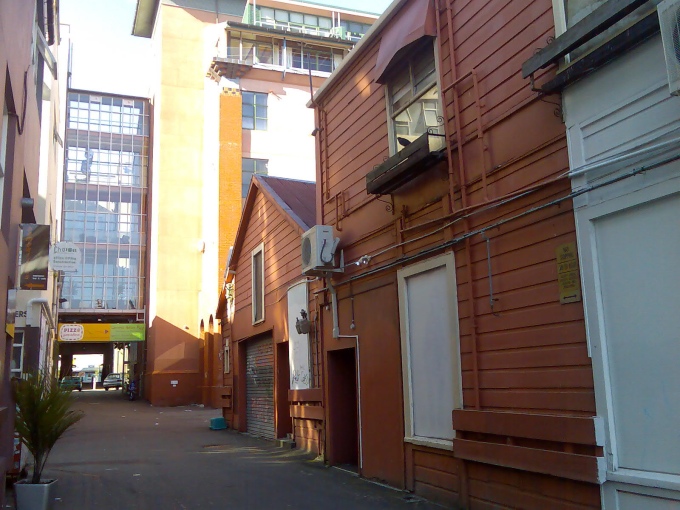
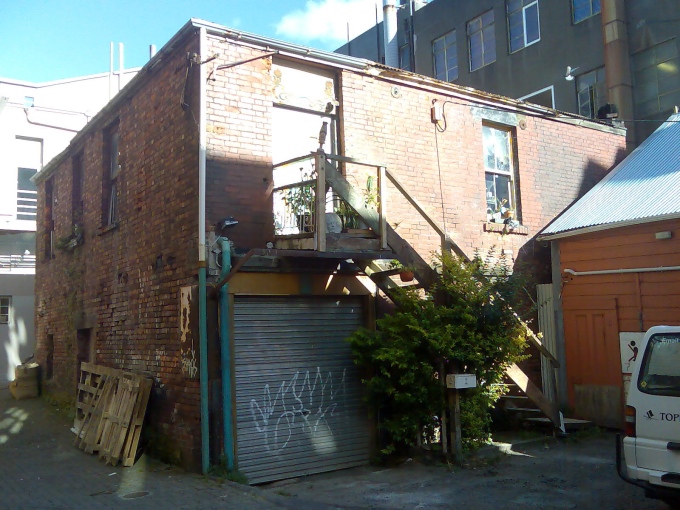


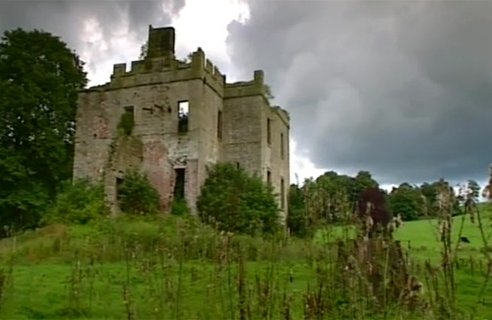

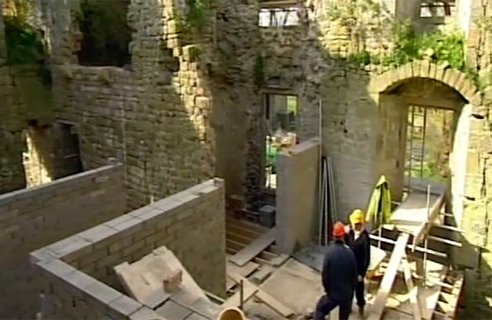
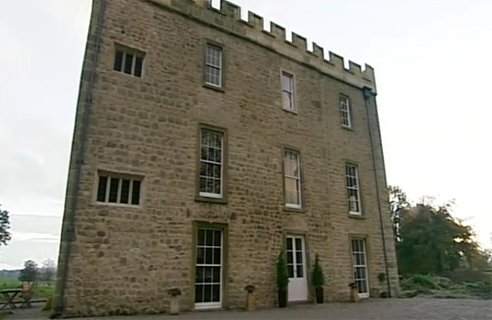
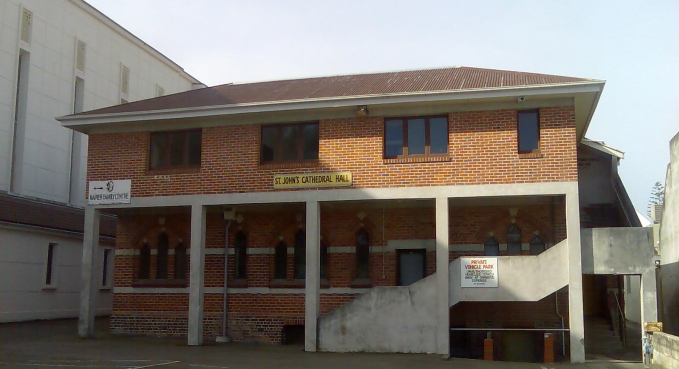



“living, breathing people and their lived-in, working buildings are so much more interesting to me than unearthing pre-Victorian pots and pans, and dead and buried piles of bones and rotting ponga.”
Couldn’t agree more.
“St Johns Church Hall in Napier”
That building is worthy of a Class I listing? SERIOUSLY?
be prepared to say goodbye to Old Wool House, which the friends and families of the owner successfully argued had no architectural value at all
Really? Arrgh! This makes me sad and angry. It’s such a handsome building. It’s got so much sexy style to it. Just because it doesn’t have any curly bits doesn’t mean it’s worthless.
I’m going to have to metaphorically smash something now.
Sorry Seamonkey Madness, but if you’d actually seen St John’s Church Hall in Napier you’d understand that it was an amazing building. This photo shows the ugly extension added some time after it was built. The original hall was cool. Quite gothic, AND it was one of the few buildings that made it through the Napier earthquake. But it couldn’t survive Napier’s inertia when it comes to anything that isn’t overtly deco.
“This photo shows the ugly extension added some time after it was built.”
Your words not mine.
As you say, it’s not the main building, which by your and Maximus’ description is extremely worthy of saving.
The problem with St Johns hall is that it is buried in the middle of a city block, surrounded by buildings, the only side visible from the street is the one posted by Maximus, short of levelling everything around it, it is very hard to actually appreciate.
There are several issues in play here, which perhaps I didn’t clarify enough. There is the question of whether St John’s Hall is worthy of a Grade 1 listing, which on the basis of my one poor photo, would certainly seem to be a No – but I’m sure on the basis of the Trust’s well put together submission, would probably indicate quite valid reasons it should (i.e. there is only a part of the original hall still in place, but this is pre-Earthquake in a almost entirely post-Earthquake city, and hence a whole lot more worthwhile keeping as a result).
There is the question over whether the Trust or the Council has any right to nominate some building or land as Heritage, if the owner disagrees with them. Whose land is it – the owner’s, or does it really belong to the community?
On the other side of that there is the question of whether the Council, as a local authority that is meant to be upholding the law, can or should over-ride the Trust as keepers of the nation’s heritage?
In relation to the omissions in Wellington, what I find very interesting and very sad, is that the developer of the sites can afford a big lawyer who blusters his or her way through the defence of the council’s heritage advisors. Presumably the Council have done their homework – they wouldn’t list something as heritage unless it was really heritage. Why / how then can someone argue that it is not, and that they have the right to knock it down?
…and that is one of the good things about the otherwise ridiculous British system – that you can’t do anything unless it has all been properly discussed and debated first.
So it may take 10 years, but at least the end result has been well thought through!
Just because someone claims an item is “heritage” does not magically make it so. After all, many of those making such a claim can have a personal stake in it such as a heritage consultant with a business who wants more heritage consulting referrals. Or staff members who wants to block a redevelopment – not for heritage reasons – but more proasaic ones such as not wanting to lose their job. In Australia we have well documented cases of heritage nominations being made as a result of a commercial dispute between a shop owner and the tenent as well as myriad other “pay backs” of retaliatory heritage nominatins.
So precisly where do you get off abusing the Vicar here? The Vicar only accessed rights of any affected owner in a modern democracy should enjoy to challenge a bureaucatic decisions they disputed the validity of. And as it turns out, they were considered correct. Using your logic all one has to do is point and say “that is heritage” for whatever motivation and the owner is supposed to roll over and accept it and not have fair access to an appeals mechanism? Let’s apply that same logic to other government decsions – your tax bill becomes a one way street, as does your university entry, passport application or drivers licence cancellation. So sorry – no appeal rights. Too bad if the original decision maker got it wrong.
This blind faith you appear to have in the pro-heritage lobby actually being able to reliably identify what is and is not a heritage building is woeful. As is your praise for the English heritage Nazis powers. Even on your own admission they would have preferred the delerelict castle to moulder into dust rather than deal equitably and fairly with an owner who not only respected heritage, but actually was motivated to pour their money, time and soul into rescistating this shell of a building. The message anyone watching that particular episode would have gleaned was this “Don’t even try.”
Heritage nutters do more to destroy heritage than any owners with legitimate appeal rights.
No George, I’m deliberately trying not to talk in specifics of the vicar here. Not trying to abuse the vicar – not really interested in abusing anyone vicars or not. Apart from that, you raise some good points – except your last comment, which seems a trifle exaggerated.
But I’ll hold back from commenting further – I’m interested in what others may want to say.
But it couldn’t survive Napier’s inertia when it comes to anything that isn’t overtly deco.
The last time I was in Napier (about three years ago) it seemed to me that Napier’s downtown area was at risk of becoming an art deco version of Disneyland’s Main Street. It’s not so much the old deco buildings, but that new buildings seem to have an obligation to be built in a pseudo art deco style. And so buildings not in the art deco style are the ones that end up standing out… that is, if they’re allowed to stand.
you should go there in the 3rd weekend of February…. then it will all make sense. Pack your hat.
Every time I walk down Eva Street (which I love because of the old shoe factory), I look at the mess of decrepit old buildings on the Courtenay Place end and wonder what you could replace them with.
Being old might make something “aged architectural heritage”. But it doesn’t mean it shouldn’t be replaced. Otherwise we’d all belong to Waterfront Watch and fight to keep tatty old wharf buildings instead of replacing them with something nice to look at.
“an obligation to be built in a pseudo art deco style”
Robyn – I completely agree with your implication – if I’ve read it correctly – the synthetic art deco farce is v. silly. Let’s build good buildings, not ones compromised by this artificial faux-deco fixtation
re: your points Maximus – I’m amazed no one’s raised the issue yet – why don’t NZHPT registrations have legal status? That’s really the thing that undermines what in theory is a relatively objective system at the HPT level.
If there’s one example of neo-Art Deco not looking cheesy, it’s the Metropolis Tower in Auckland. Its developer actually flew the architects to New York to give them some feast for thought.
…and then went bust, owing millions. While I do think that it is an enlightened client who would take such a trip, and take the architects as well (and it may well have been the other way round, with the architects taking the client on an education trip) there is still something clunky and ill proportioned about Metropolis. It may have some of the features of, but certainly doesn’t have any of the charm of a real Deco era building.
Metropolis is in a strange site. It’s on High Street, which is a little boutiquey lane that runs parallel to Queen Street. There’s never a moment where you can find yourself standing at the bottom of Metropolis, gazing up in awe like you can do with the Sky Tower and various other tall buildings in Auckland.
When you are in a position to admire Metropolis’ vastness, then you’re so far away that it becomes just another building on the Auckland skyline.
Metropolis is the architectural consequence of not keeping it in yo’ pants.
Sorry Seamonkey Madness, but if you'd actually seen St John's Church Hall in Napier you'd understand that it was an amazing building. This photo shows the ugly extension added some time after it was built. The original hall was cool. Quite gothic, AND it was one of the few buildings that made it through the Napier earthquake. But it couldn't survive Napier's inertia when it comes to anything that isn't overtly deco.